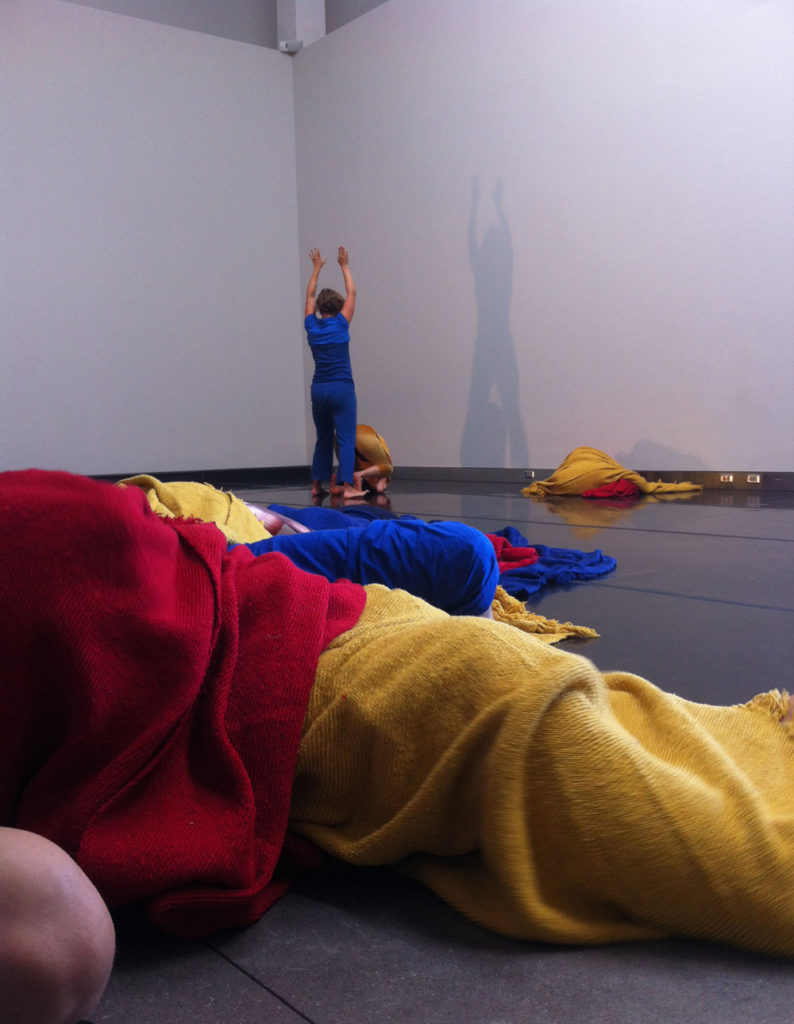BodyCartography: The Body-Cartography Project
Review I by Damon Stanek
Weisman Art Museum
Jul 11–Aug 8, 2018

Dance is an affective immigrant into the art museum. Olive Bieringa and Otto Ramstad’s collaborative dance company, BodyCartography Project, just completed a five-week residency at the Weisman Art Museum, inspiring questions of attention and focus as they dissolved the space between performer and viewer, thereby asking us to reflect upon the figurative phrase: ‘that work touched me.’
At the core of the project was a series of collaborative workshops with the dancers and medical students entitled A Place of Space. Embryonic, both conceptually and symbolically, it exploited our art-gallery habits and sought to build a relationship between art and science. As Bieringa noted in her artist talk: “Duration is a privilege that exists in the museum.” This was my first encounter with their work, and I joined the audience at the edge of the dance-floor. The five dancers wearing red, yellow or blue were distributed—in groups of two and three—among correspondingly colored blankets on the floor. As the piece commenced, one of the students began to periodically call out biological terms: morphogenesis, cardio-genesis, looping, folding, migrating, neuro-genesis. The dancers improvised, in laconic arcs of action, keeping two or three points of contact with their partners. Slowly, they migrated across the floor, cleaving and extending off individually. What disturbed me about the work was the manner art had relinquished its power to science. I left the first performance reflecting upon society’s elevation of science as a discourse of truth and authority.
By a simple twist of fate, I saw a second performance. An announcement preceded it declaring the medical student would be calling out interpretations of what she was seeing. This pulled the work inside out for me, art was the grounding discourse, rather than science. In this way, dance was fostering an ethical encounter, rather than falling into the trappings of morality. Very subtle, maybe even fragile, these encounters relied upon the privileged duration of the museum.
As I marveled at the sense of grace their silent motion conveyed, two intertwined dancers moved toward me. Feeling protected, outside the borders of the marley, I was surprised as they rolled across the imaginary border making gentle contact with me. This simple touch changed how I was thinking about the work—as did Olive Bieringa’s swaddling each audience member in a blanket. I was not witnessing a series of bodily representations of neurogenesis, but rather the sense of becoming that is involved with the biological processes as the duration unfolded.
Action Movie found one dancer and one spectator exploring the museum space together. The dancer controlled the action, framing the experience for the viewer who, with eyes closed, was led by the hand through the museum. Vision is our dominant sense, and we often anesthetize the others to focus more attention to optical sensations. Action Movie foregrounded this fact by radically limiting vision enabling other senses to bloom. This too is an ethical relation. The dancer guided the viewer toward a situation and asked them to open their eyes, confronting the viewer with an edited reality. Viewers were laid upon the ground, given new vantage points at a sculpture, while others witnessed duets with folding chairs or their own shadows. Yet the work was also rich when experienced with your eyes closed merely listening to the dancer move around your body, or feeling the hot-summer air, slipping past a cracked door, caressing your face. As a non-dancer, this work, as well as the BodyCartography Project, succeeded in highlighting rich embodied experiences rather than privileging the optical. These may not be new lessons for artists or audiences, but institutions seem to keep forgetting the ways in which a work can touch us.
